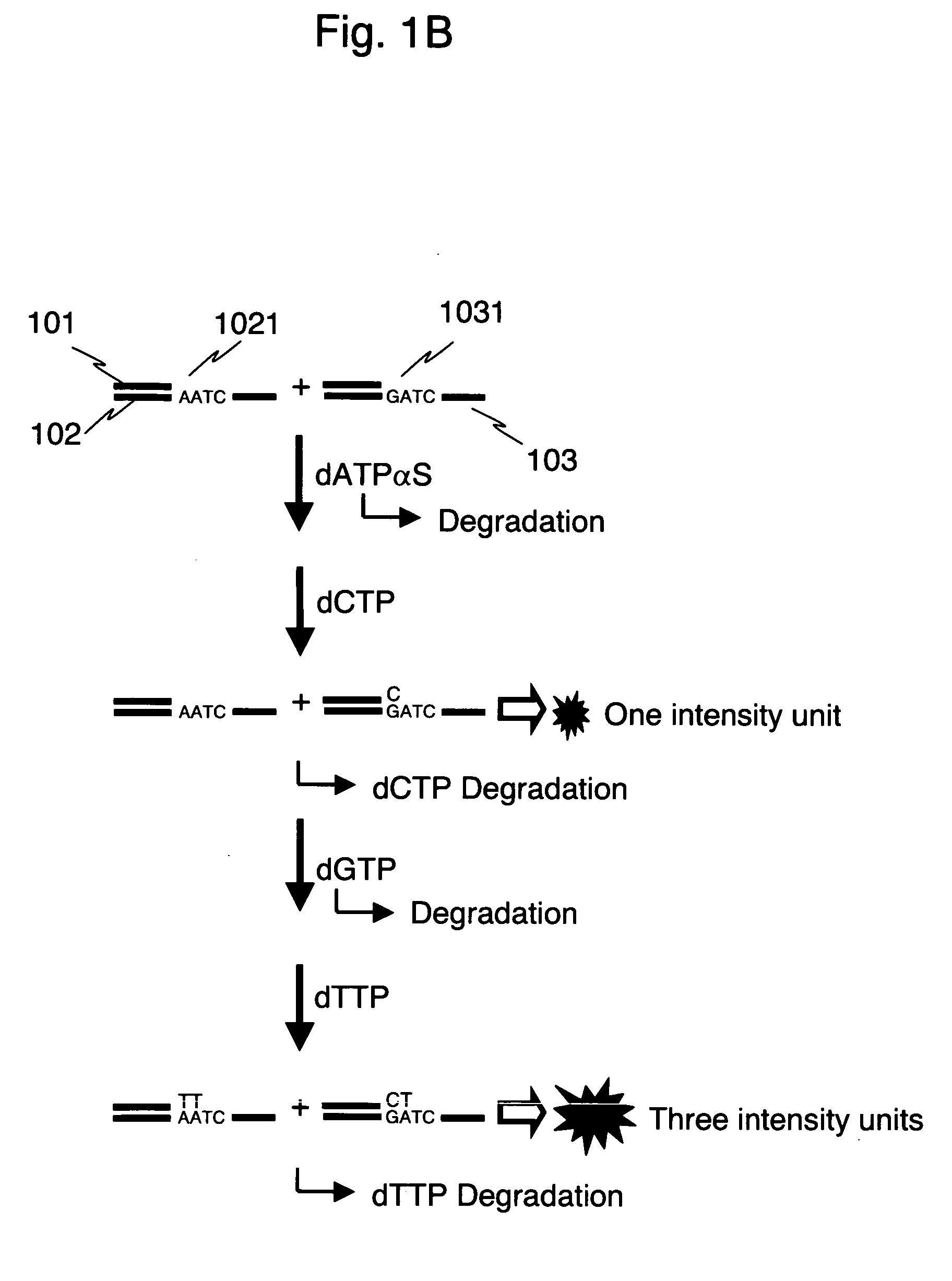Multiplex SNP typing by bioluminometric assay coupled with terminator incorporation
- Summary
- Abstract
- Description
- Claims
- Application Information
AI Technical Summary
Benefits of technology
Problems solved by technology
Method used
Image
Examples
example 1
[0036]FIG. 1 shows comparison between stepwise reactions according to a method of the present invention and stepwise reactions of a pyrosequencing method. The gene of a human individual consists of a pair of two kinds of alleles derived from father and mother, respectively. In the present example, an example of a heterozygous sample having each of two kinds of alleles different in A / G at a polymorphism site is explained.
[0037] Each of the numerals 102 and 103 in FIG. 1 shows one strand of DNA from each of two alleles representing a polymorphism A (1021) and a polymorphism G (1031), respectively. With the use of a common primer 101, SNP typing according to the method of the present invention is shown in Fig. 1A, and SNP typing by a conventional pyrosequencing method is shown in Fig. 1B. Luminescence intensity when a reaction of complementary strand synthesis takes place is proportional to the number of nucleotides incorporated in the complementary strand synthesis. For simplicity, t...
example 2
[0048] In the example 1, the reaction for the conversion of pyrophosphate to ATP made use of ATP sulfurylase by which ATP was formed from pyrophosphate and APS. Although the activity of APS as a luminescent substrate for luciferase is low as mentioned above, luminescence caused by APS became nonnegligible when APS was present in a large amount in the reaction vessel. Moreover it sometimes lowered the sensitivity of detection. For this reason, a system in which AMP that is unable to serve as a substrate for luciferase reaction is used as a substrate for reaction with pyrophosphate and both are reacted with the use of pyruvate phosphate dikinase (PPDK) will be explained. The outline of the reaction in the present example is shown in FIG. 5. Although the method of the present example was almost the same as that of the example 1 except for ATP formation process, reagents and reaction conditions to be used differed to some extent because conditions were set to become appropriate for the ...
example 3
[0052] The method of the present invention allows multiplex SNPs to be typed in one reaction vessel. As a first example, a case in which typing targets are three SNPs will be explained.
[0053] In most cases, SNPs consist of a general type (wild type) and a type in which the one nucleotide of concern is substituted by a specific nucleotide of the other three nucleotides (mutant type). In other words, variations at a SNP site are usually two kinds. Therefore, when three SNPs are typed at the same time, the number of nucleotides to be identified is six in total (2×3). Since the nucleotides present in nature are four kinds consisting of A, C, G, and T, possible combinations of the six nucleotides are 27 in total assuming that SNPs with an identical combination are not measured for the three SNPs at the same time. Thus, the conditions required for complete identification of three SNPs are as follows.
[0054] First, it is necessary to select typing target SNPs such that three SNPs do not h...
PUM
| Property | Measurement | Unit |
|---|---|---|
| Volume | aaaaa | aaaaa |
| Volume | aaaaa | aaaaa |
| Volume | aaaaa | aaaaa |
Abstract
Description
Claims
Application Information
 Login to View More
Login to View More - R&D
- Intellectual Property
- Life Sciences
- Materials
- Tech Scout
- Unparalleled Data Quality
- Higher Quality Content
- 60% Fewer Hallucinations
Browse by: Latest US Patents, China's latest patents, Technical Efficacy Thesaurus, Application Domain, Technology Topic, Popular Technical Reports.
© 2025 PatSnap. All rights reserved.Legal|Privacy policy|Modern Slavery Act Transparency Statement|Sitemap|About US| Contact US: help@patsnap.com



